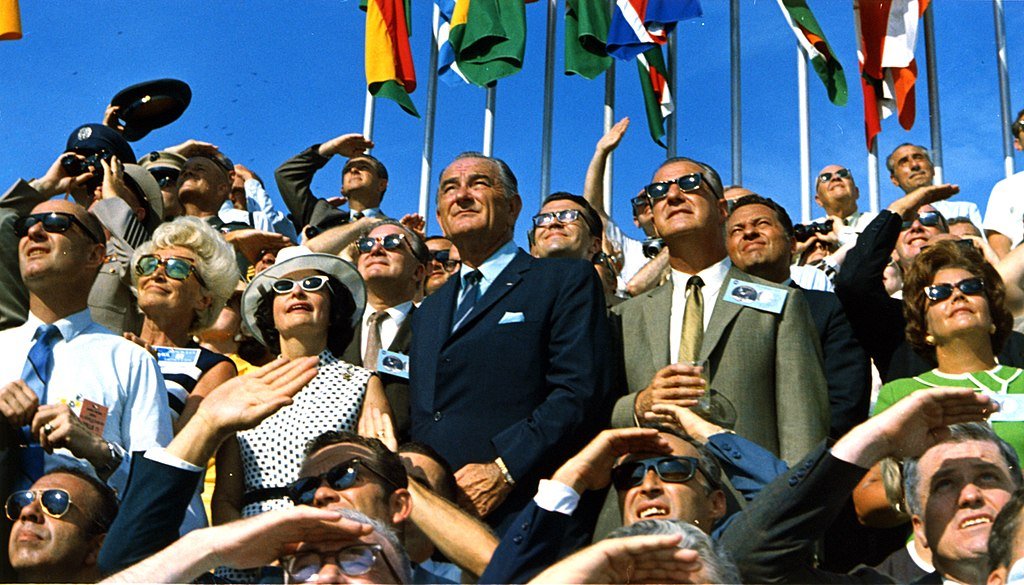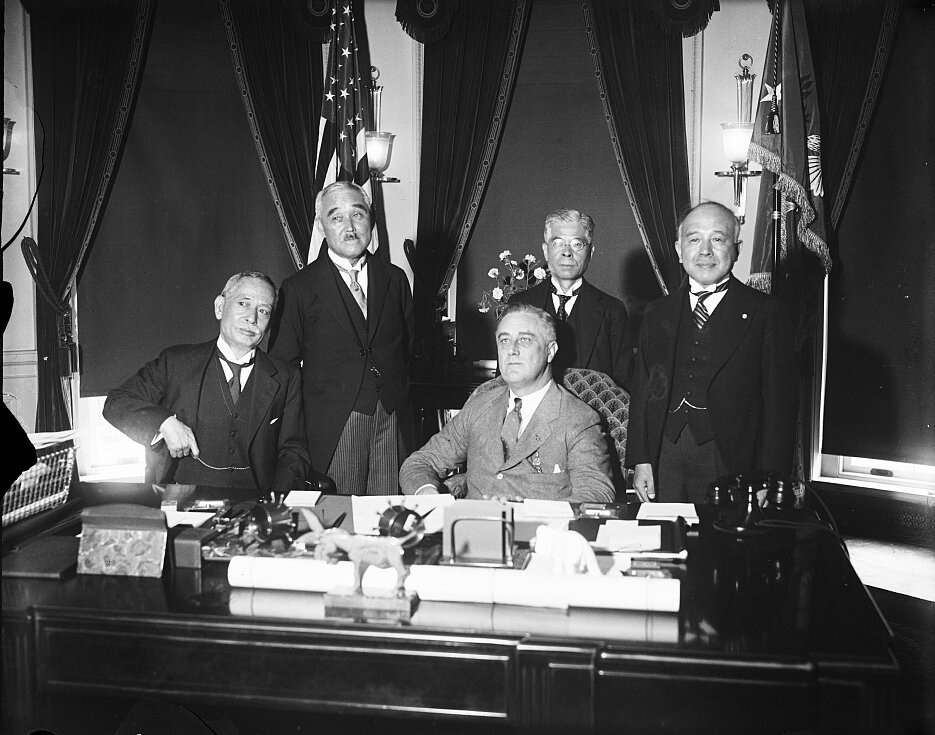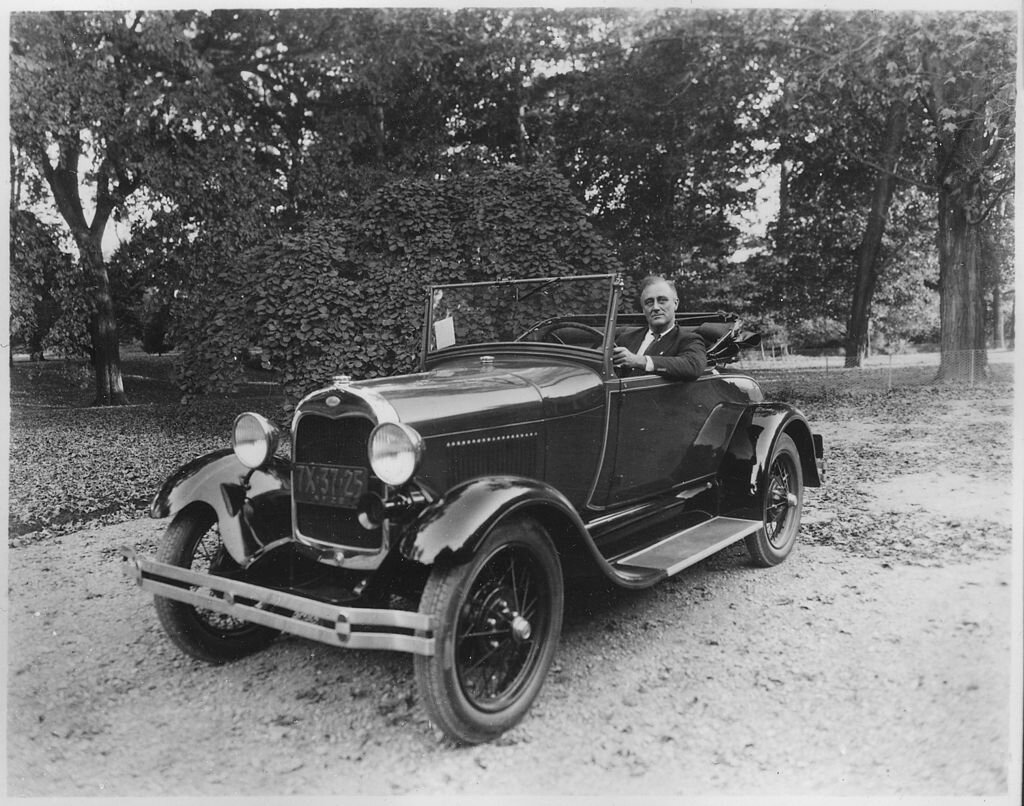Franklin D. Roosevelt was US President from 1933 to 1945 - the years of the Great Depression through to the end of World War 2. What is less well known is that he was paralyzed by illness in 1921 and did not have full use of his legs from that time. Here, Richard Bluttal explores the affect of paralysis on Roosevelt’s presidency.
President Roosevelt in a wheelchair with a girl in February 1941. Source: FDR Presidential Library & Museum photograph by Margaret Suckley, available here.
Franklin D. Roosevelt was US President from 1933 to 1945 - the years of the Great Depression through to the end of World War 2. What is less well known is that he was paralyzed by illness in 1921 and did not have full use of his legs from that time. Here, Richard Bluttal explores the affect of paralysis on Roosevelt’s presidency.
Speaking at a Georgia rally in 1932 Franklin Delano Roosevelt addresses the crowd, as was his practice, from a standing position, holding onto a podium bolted to the floor. By inadvertence, this one, however, was not bolted and midway into his speech podium the presidential candidate pitched forward into the orchestra pit. The audience was spellbound as the candidate and podium were retrieved from the pit and set back upon the stage. Roosevelt finished his speech, taking up from the point at which he had stopped, without giving either comment or acknowledgement to his fall. At the conclusion he received a standing ovation.
When Franklin D. Roosevelt woke up on August 10, 1921, with plans to take his wife and three older children out for a sail in New Brunswick, Canada, he had no idea that it would be the last day he would have full use of his legs. Enjoying some vacation time after running for vice president under James Cox, FDR and his kids sailed the scenic waters near Campobello Island. Afterward, they had a swim in a nearby pond and then he raced the kids back to the cottage. But it was when they returned to the cottage that Roosevelt began to feel odd, feverish and more tired than usual. He decided to skip dinner and go right to bed. “And he never walked without help again,” says Biographer Geoffrey C. Ward. When he woke the next morning, he couldn’t move his left leg, and then his right leg gave way. “I tried to persuade myself that the trouble with my leg was muscular,” Roosevelt wrote later, “that it would disappear as I used it. But presently it refused to work. And then the other.” Two days later, he lost the use of all his muscles from the chest down. He also had a high fever and pain in his neck and back.
Paralysis
The life of Franklin Delano Roosevelt is an astonishment. In 1921, at the age of 39, he was struck by this attack of infantile paralysis which left him paralyzed below the waist for the rest of his life. In a time when the severely handicapped were seldom even seen in public, FDR resumed his political career. He was twice elected governor of New York and in 1932 he was elected president of the United Sates. No one else in the recorded history of mankind has been chosen as the leader of his people even though he could neither stand alone nor walk unassisted.
His leg muscles were graded as "poor" and "trace" -- and thus were unable to function in any useful manner. In order to stand upon his legs FDR had to don long-leg steel braces. The gluteus maximus muscles of his hips were similarly impaired. The muscles of his trunk were weak and as a result, in the early stages of his rehabilitation, he was forced to wear a corset and to struggle with a pelvic band attached to his braces.
Paralysis resulting from an attack of infantile paralysis, or poliomyelitis, is confined to the nerves that control the voluntary muscles. FDR had virtually normal function of his sensory and autonomic nervous system. This meant that his digestive tract, his bowels and bladder functioned normally, as did his sexual organs. The onset of the disease had a shattering impact upon the man and his expectations. Clearly both he and Eleanor, his wife and closest political adviser, believed that public knowledge of the extent of the disease, like family scandal, would endanger FDR's political future. The severity in nature of the attack was kept secret from all but the closest family members and at first the press was told only that Roosevelt had contracted a case of influenza.
As noted by author Hugh Gregory Gallagher, FDR tried everything that had been used in the past. He tried massage, salt-water baths, ultraviolet light, electric current, walking on braces with parallel bars at waist height, walking while hanging from parallel bars mounted above his head. He tried horseback riding strapped to the saddle; he tried an electric tricycle his mother had brought from Europe. He tried exercises in warm water and exercises in cold water. He tried various theories of muscle training: working with gravity, against gravity, with resistance and without. He tried osteopathy. Even the eminent doctor, Emile Coue, ("every day in every way I'm getting better and better,") was consulted on his behalf.
During his 12 years in the White House, Franklin D. Roosevelt was hardly ever photographed in a wheelchair. Not surprisingly, the longest-serving president in American history disliked drawing attention to his polio symptoms, he still led the country from a wheelchair. He was helped -- most often lifted bodily -- into or out of cars, tubs, chairs or beds. Journalist John Gunther reports it was a startling experience to see the president of the United States being carried up and down stairs "like a sack of potatoes," as his son James once described it.
Roosevelt stood up only for ceremonial occasions and only for as long as was absolutely necessary. He was able to stand only with the support of his braces and crutches. His braces caused him pain and he despised them roundly. He was able to "walk" only by the use of "hitching" the muscles on either side of his trunk. Leaning on his crutches, he would hike first one leg, swing it forward, transfer the weight of his body upon it and then, hiking up the other, he would swing it forward. This means of locomotion was a slow, lurching process. It was made worse by a drop foot which forced him to swing his foot around and forward in a wide arc so as to clear the ground.
Running for president
He never learned how to walk again but he learned, instead, how to get on with his life using what muscles he had left. He learned this at Warm Springs, Ga. At Warm Springs, he created what was in many ways the first modern rehabilitation center. Warm Springs was a reflection of Franklin Roosevelt's personality and philosophy, his enthusiasm and motivation. These were the same qualities Roosevelt later brought to the presidency. They were fully as effective in Washington as they had been in Georgia.
Though the public may not have been aware of the extent of his disability, most knew that his battle with polio left him with limited mobility. James Tobin, author of The Man He Became: How FDR Defied Polio to Win the Presidency, believes that Roosevelt’s disability may have helped him to be elected and given him more empathy for the common man. Tobin told NPR’s Dave Davies that FDR had “a kind of passion for people who are suffering that he couldn’t have had if he had not deeply suffered himself.”
Surprisingly, the subject of his inability to walk never became an issue during his campaign for president in 1932. FDR preferred not to speak of it, even to his family, as he did not want sympathy or pity—what he referred to as “sob stuff.” But the fact is FDR’s disability only strengthened his determination and resolve. He was perhaps a better president as a result of his condition, as it taught him perseverance and gave him a sense of compassion and acceptance for those less fortunate. “Human kindness has never weakened the stamina or softened the fiber of a free people,” he said. “A nation does not have to be cruel to be tough.”
Optimism
Roosevelt's fate could have been similar to that of many polio victims, except for his political ambition and his inherent optimism. Roosevelt understood very well the fate of a disabled person, not to speak of a disabled person with political ambitions. Physical disability was an automatic disqualification for public life, let alone for the highest political office. His chances lay in his ability to hide his disability. Yet, these very efforts reflected "a view of the disabled body as stigmatizing, shameful, and as a physical marker of weakness of intellect and character"
Roosevelt realized that when you were crippled — and that was the word that he would use — you have a tendency to make people uncomfortable. People don't know what to say, they don't know where to look, they don't know how to treat you, they don't know whether to feel pity for you, when pity is the last thing that you want. He had to persuade people to feel comfortable in his presence. The therapists and he began to work on his gait, to work on the way he would walk with the canes and crutches and assistance he would use. So his walk, although slow, began to look more and more natural. And he would seat himself, and he would throw up his head, he would begin to talk — he was always talking, actually — to put people at ease. And this whole physical routine that he developed of putting people at ease was enormously effective, and it made people forget that he was disabled.
In a speech in Rochester, N.Y., he was talking about the needs of disabled children in the state of New York and he mentions himself. He says, "I myself have been through this ordeal, and I am a symbol of what can happen when people with disabilities are strongly supported." And nobody had expected him to say this out loud; nobody had expected him to address this issue in this way, to turn the disability on its head and make it into this advantage. And so it had [an] electrifying effect on the audience. ... I think Roosevelt ... realized this was a strong part of his presence as a candidate, and it was something that actually appealed to people.
In the decades after his death, a narrative emerged about the extent of Roosevelt's deceptions to hide his condition from the American people. It's true that Roosevelt made every effort to appear as able-bodied as possible, only appearing in public through carefully orchestrated maneuvers that showed him "walking" a short distance. The press was discouraged from focusing on vulnerable moments, and for the most part, he was photographed either sitting down or speaking at a carefully fastened podium.
But the president's disability was never a secret. Prior to entering the White House, he had been profiled in major publications like Time and Liberty, which displayed his heavy leg braces and detailed the excruciating efforts he underwent to hoist himself around on unresponsive legs. The Liberty article, in particular, addressed the elephant in the room of whether a "cripple" was fit to be president, concluding that FDR was more physically sound than most men half his age. On a personal level, those close to Roosevelt felt that dealing with his disease made him a better leader. The younger FDR had been known to harbor arrogance along with his impressive intellect, but that version was replaced by a more grounded, empathetic person. "There had been a plowing up of his nature," noted his longtime labor secretary, Frances Perkins. "The man emerged completely warm-hearted, with new humility of spirit and a firmer understanding of philosophical concepts.”
Conclusion
Roosevelt embraced his status as a polio survivor and fully leveraged his position to help others who were similarly afflicted. He held the first of his "birthday balls" in 1934 to raise money for polio research, an endeavor that eventually became the March of Dimes and led to the discovery of a cure in the form of a vaccine developed by U.S. researcher Jonas Salk. By meeting his disease head-on, Roosevelt turned it into a non-issue when it came to doing his job while spearheading a way to stamp it out as a public menace.
FDR’s permanent association to a failing body serves as a reminder that in addition to steering America through the Great Depression and World War II, FDR managed to convince a public that his physical disability was no hindrance.
What do you think of the article? Let us know below.
Now read Richard’s piece on the history of slavery in New York here.













